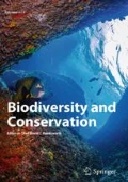Ver ítem
- xmlui.general.dspace_homeCentros Regionales y EEAsCentro Regional Patagonia NorteEEA BarilocheArtículos científicosxmlui.ArtifactBrowser.ItemViewer.trail
- Inicio
- Centros Regionales y EEAs
- Centro Regional Patagonia Norte
- EEA Bariloche
- Artículos científicos
- Ver ítem
Predicting the distribution of plant species from southern South America: are the hotspots of genetic diversity threatened by climate change?
Resumen
Biodiversity in all its dimensions is being threatened by climate change and the impact of human activities. Genetic diversity is a key dimension of biodiversity underlying adaptation to global changes. Here we assess the impact of climate change on plant genetic diversity in a region located in the southernmost portion of Argentina and Chile range. We compiled available published research on population genetics of 22 plant species from forests, monte and
[ver mas...]
Biodiversity in all its dimensions is being threatened by climate change and the impact of human activities. Genetic diversity is a key dimension of biodiversity underlying adaptation to global changes. Here we assess the impact of climate change on plant genetic diversity in a region located in the southernmost portion of Argentina and Chile range. We compiled available published research on population genetics of 22 plant species from forests, monte and steppe ecoregions and modelled the impact of future climates on their suitability distributions. Based on our results, 7 out of 22 species are predicted to lose more than 50% of their current suitable areas being the average loss across all species 40% (SSP 126) and 45% (SSP370). Several hotspots where species richness and genetic diversity overlap are located in areas that are predicted to become unsuitable, particularly in northern Patagonia, Argentina. Along the Arid Diagonal, some steppe and monte species are predicted to lose areas. Stable areas, on the other hand, were identified, to the west and south of the Andes, thus offering opportunities to preserve the genetic variants that might be critical for adaptation. Although higher temperatures will be threatening in the future, some of the areas we identify might act as promising natural refuges for southern South America flora, as long as appropriate conservation and management policies of the genetic resources are being implemented.
[Cerrar]

Autor
Soliani, Carolina;
Ceccarelli, Viviana;
Lantschner, Maria Victoria;
Thomas, Evert;
Marchelli, Paula;
Fuente
Biodiversity and Conservation 33 (2) : 725-757. (February 2024)
Fecha
2024-01
Editorial
Springer
ISSN
0960-3115
1572-9710
1572-9710
Formato
pdf
Tipo de documento
artículo
Palabras Claves
Derechos de acceso
Restringido
 Excepto donde se diga explicitamente, este item se publica bajo la siguiente descripción: Creative Commons Attribution-NonCommercial-ShareAlike 2.5 Unported (CC BY-NC-SA 2.5)
Excepto donde se diga explicitamente, este item se publica bajo la siguiente descripción: Creative Commons Attribution-NonCommercial-ShareAlike 2.5 Unported (CC BY-NC-SA 2.5)


